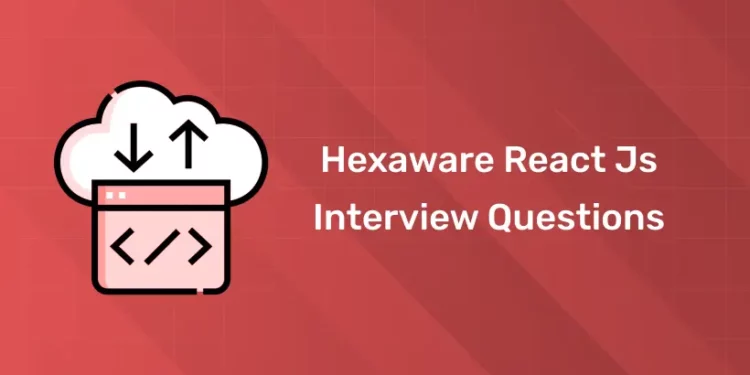Table of Contents
Hexaware Technologies is known for its innovative approach to digital transformation, and React JS plays a key role in the development of modern, dynamic web applications. If you’re preparing for a React JS interview at Hexaware, it’s crucial to have a solid understanding of core React concepts, along with practical problem-solving skills. In this blog, we’ll explore some of the most commonly asked React JS interview questions at Hexaware, covering topics such as components, state management, hooks, and more. Whether you’re a seasoned developer or just starting your React journey, these questions will help you prepare effectively for your upcoming interview.
Learn Full Stack Development with expert mentors! Get Free Demo Here!
Introduction
Hexaware Technologies is a global IT services and consulting company that specializes in digital transformation, cloud computing, automation, and artificial intelligence. Founded in 1990, Hexaware serves a wide range of industries including banking, financial services, healthcare, and retail. The company operates in over 30 countries and focuses on helping businesses optimize their operations through innovative technology solutions. Hexaware places a strong emphasis on automation and cognitive services to deliver cost-effective results and improve client experiences. Known for its client-centric approach, Hexaware builds long-term relationships by offering tailored, cutting-edge solutions that drive efficiency and agility.
Why Join in Hexaware?
Joining Hexaware can be a great choice for professionals looking to grow in the IT and consulting industry. Here are some reasons why you might consider joining Hexaware:
1. Innovative Work Environment: Hexaware places a strong emphasis on digital transformation and automation, giving employees the opportunity to work on cutting-edge technologies like AI, cloud computing, and machine learning.
2. Career Growth: The company offers a range of training programs, skill development initiatives, and opportunities for advancement, allowing employees to continuously grow and develop their careers.
3. Global Exposure: With operations in over 30 countries, Hexaware provides its employees with global exposure and the opportunity to work with a diverse range of clients across industries like banking, healthcare, and retail.
4. Focus on Innovation: Hexaware invests heavily in research and development, making it a great place for those who are passionate about innovation and technology.
5. Work-Life Balance: The company promotes a healthy work-life balance, with policies that support flexibility, employee well-being, and a positive work environment.
6. Employee-Centric Culture: Hexaware fosters an inclusive, employee-friendly culture with a strong focus on teamwork, collaboration, and employee engagement.
Hexaware Interview Preparation Tips for react js
To prepare for a Hexaware React JS interview, you can focus on the following tips:
1. Understand the Fundamentals of React:
- Be clear with the basic concepts like components, JSX, props, state, and lifecycle methods.
- Practice functional components and the use of hooks like
useState,useEffect, etc.
2. Master React Hooks:
- Know how hooks work, especially
useState,useEffect,useContext, anduseReducer. - Be prepared to explain the use of hooks in real-world applications and how they replace lifecycle methods.
3. Component Lifecycle:
- Even though hooks are widely used, you should know the class component lifecycle methods such as
componentDidMount,componentDidUpdate, andcomponentWillUnmount.
4. State Management:
- Be familiar with managing state using Context API or libraries like Redux.
- Understand how to structure an application with state at different levels and passing down state through props.
5. Event Handling and Forms:
- Be comfortable with handling events, managing form inputs, and validating data in React.
- Know how controlled and uncontrolled components work.
6. React Router:
- Learn how routing works with
react-router-dom. Be prepared to explain concepts like nested routes, dynamic routes, and route guards.
7. Optimizing React Applications:
- Understand performance optimization techniques in React like memoization (
React.memo,useMemo,useCallback). - Know how to prevent unnecessary re-renders and optimize component updates.
8. Testing in React:
- Be aware of testing tools like Jest and React Testing Library.
- Prepare to explain how to write unit tests for React components.
9. APIs and Asynchronous Calls:
- Understand how to fetch data using
fetchoraxiosin React. - Know how to handle asynchronous logic and loading/error states within components.
10. React with TypeScript (if applicable):
- If the job requires, practice React with TypeScript. Know how to type components, props, and states.
11. Version Control and Collaboration Tools:
- Be familiar with Git, version control, and working in a collaborative environment.
12. Real-World Application Building:
- Practice building small React projects and deploy them on platforms like Netlify or GitHub Pages. This demonstrates your hands-on experience.
Learn Full Stack Development with expert mentors! Get Free Demo Here!
Top Hexaware react js Interview Questions and Answers
1. What is React?
Answer: React is a JavaScript library for building user interfaces, primarily single-page applications where data can change dynamically without reloading the entire page. It allows developers to create reusable UI components.
2. What are the main features of React?
Answer:
- JSX: A syntax extension that allows mixing HTML with JavaScript.
- Components: Reusable pieces of UI.
- Virtual DOM: React creates a virtual representation of the real DOM, making updates efficient.
- One-way data binding: Data flows in one direction, making the code more predictable.
3. Explain the difference between state and props in React.
Answer:
- Props: Short for properties, these are read-only data passed from parent to child components.
- State: A component’s local data that can change over time and is managed within the component.
4. What are React Hooks? Can you name a few commonly used hooks?
Answer: Hooks are functions that let you use state and other React features in functional components. Commonly used hooks include:
- useState: Manages state in functional components.
- useEffect: Handles side effects like data fetching or subscriptions.
- useContext: Provides a way to share values between components without passing props.
5. What is the Virtual DOM and how does it work in React?
Answer: The Virtual DOM is a lightweight representation of the actual DOM. When the state of an object changes in React, a new Virtual DOM is created. React then compares this new Virtual DOM with the old one (using a process called “diffing”) and updates only the parts of the real DOM that have changed.
6. Explain the purpose of useEffect in React.
Answer: useEffect allows you to perform side effects in functional components. It can be used to fetch data, directly manipulate the DOM, or subscribe/unsubscribe from services. It runs after the render and can be controlled to run only when specific state values change.
7. How would you optimize a React application?
Answer:
- Use React.memo to prevent unnecessary re-renders.
- Use useMemo and useCallback hooks to optimize expensive calculations and functions.
- Avoid inline functions and inline object/array declarations in component renders.
- Split code using React.lazy and Suspense for loading components only when necessary.
- Keep component hierarchy shallow.
8. What is the Context API and how does it work in React?
Answer: The Context API is used to share data globally across components without having to pass props down manually at every level. You create a context using React.createContext(), and the data provided by a context provider is accessible to all components that consume the context.
9. What is a controlled component in React?
Answer: A controlled component is one where the form element’s value is controlled by React through state. The input’s value is driven by the component’s state and changes when the state is updated.
10. What is the difference between functional and class components in React?
Answer:
- Functional components are stateless and typically used to present UI. However, with React hooks, they can now manage state and side effects.
- Class components can have state and lifecycle methods, but they require more boilerplate code than functional components.
11. How does the useRef hook work?
Answer: useRef returns a mutable ref object which can be used to persist values between renders or directly access DOM elements. The useRef object doesn’t trigger a re-render when its value is updated.
12. How does React.memo work?
Answer: React.memo is a higher-order component that optimizes functional components by preventing re-renders if the props haven’t changed. It works similarly to PureComponent for class components.
13. What are React Fragments, and why do we use them?
Answer: React Fragments let you group multiple elements without adding extra nodes to the DOM. Instead of wrapping elements with a div, you can use React.Fragment or its shorthand <>.
14. What is PropTypes in React?
Answer: PropTypes is a type-checking feature that helps ensure the props passed to a component are of the correct type, making the code more robust and reducing bugs.
15. How do you handle forms in React?
Answer: Forms in React can be handled using controlled components, where form inputs are controlled by the component’s state. You can also use event handlers such as onChange to update the state when the user inputs values.
16. Explain the purpose of keys in React.
Answer: Keys help React identify which items have changed, been added, or removed. This is particularly useful when rendering lists, as it helps with efficient updates by giving each item a unique identifier.
17. What is the purpose of useCallback hook?
Answer: The useCallback hook is used to memoize a function so that it only gets recreated if its dependencies change. This is useful when passing functions to child components to prevent unnecessary re-renders.
18. How do you fetch data in a React component?
Answer: You can fetch data in React using the fetch API or libraries like axios, usually inside the useEffect hook to ensure that the data is fetched after the component mounts.
19. What is the difference between useEffect and useLayoutEffect?
Answer:
- useEffect is executed after the render is committed to the screen.
- useLayoutEffect runs synchronously after all DOM mutations and before the browser updates the screen, making it suitable for measuring DOM elements or triggering animations.
20. What is lazy loading in React, and how is it implemented?
Answer: Lazy loading is a technique to load components only when they are needed, which improves performance. In React, you can implement lazy loading using React.lazy() and Suspense to load components dynamically.
Learn Full Stack Development with expert mentors! Get Free Demo Here!
Advanced Hexaware react js Interview Questions and Answers
1: Which of the following is a JavaScript framework/library?
Here are some advanced React JS interview questions and answers tailored for Hexaware:
1. What is the difference between useMemo and useCallback?
Answer:
- useMemo: Memoizes the result of a function to avoid recalculating expensive operations unless dependencies change.
- useCallback: Memoizes the function itself to prevent re-creating the function on every render unless dependencies change. Use
useMemofor expensive calculations anduseCallbackfor functions passed as props to avoid unnecessary re-renders.
2. What is the React Fiber architecture?
Answer: React Fiber is the new reconciliation algorithm in React 16, allowing React to split rendering work into chunks. This enables React to pause, abort, and resume rendering as needed, making updates more responsive and improving performance in complex applications.
3. Explain how React Concurrent Mode works.
Answer: Concurrent Mode allows React to work on multiple tasks simultaneously. It enables React to pause rendering, prioritize updates, and manage tasks asynchronously, giving priority to more urgent updates. It improves user experience by making the UI more responsive.
4. How do you handle server-side rendering (SSR) in React?
Answer: Server-side rendering in React can be achieved using libraries like Next.js. SSR allows the React component to be rendered on the server and sent to the client as fully-rendered HTML, improving initial load time and SEO.
5. What is React Suspense and how does it work with Concurrent Mode?
Answer: React Suspense is a feature that lets components “wait” for something like data fetching before rendering. It is often used with Concurrent Mode to pause rendering until the required data is loaded, ensuring that the UI doesn’t appear broken or incomplete.
6. What is code splitting in React, and how can it be implemented?
Answer: Code splitting is a technique to divide your code into smaller bundles, which are loaded only when needed, reducing the initial load time. It can be implemented using React.lazy() and Suspense or Webpack’s dynamic import() syntax.
7. How would you optimize the performance of a React application with thousands of components?
Answer:
- Use
React.memo: Memoize components to prevent unnecessary re-renders. - Use
useMemoanduseCallback: Memoize expensive calculations and callback functions. - Lazy load components: Use
React.lazy()andSuspenseto load components on demand. - Code splitting: Split the code into smaller bundles.
- Virtualization: Use libraries like react-window or react-virtualized to render only visible components.
- Avoid inline functions and objects: They create new instances on every render.
8. Explain how you would manage state in a large-scale React application.
Answer:
- For local component state, use
useStateanduseReducer. - For global state, use Context API or Redux.
- If dealing with complex data flows, Redux or other state management libraries (like MobX) help keep the state predictable and manageable.
- Use Redux Thunk or Redux Saga for handling side effects like asynchronous data fetching.
9. What are React Portals and when would you use them?
Answer: React Portals allow you to render components outside of their parent component’s DOM hierarchy. They are useful for scenarios like rendering modals, tooltips, or dropdowns, which need to be visually above other elements but remain logically within the React component tree.
10. What is React’s Profiler API, and how can it help improve performance?
Answer: The React Profiler API is a tool that helps measure the rendering performance of components. It captures timings for component rendering, identifying bottlenecks or unnecessary re-renders. You can wrap components with Profiler to monitor and analyze rendering performance.
11. How do you handle error boundaries in React?
Answer: Error boundaries are React components that catch JavaScript errors anywhere in their child component tree and display a fallback UI instead of crashing the whole app. You implement them by defining a class component with the componentDidCatch and getDerivedStateFromError lifecycle methods.
12. What is the difference between controlled and uncontrolled components in React?
Answer:
- Controlled Components: The form input’s value is controlled by React via the component’s state. Any change triggers an update in the state.
- Uncontrolled Components: React does not control the input’s value; instead, you access the DOM element directly via refs.
13. What is Recoil, and how does it differ from Redux?
Answer: Recoil is a state management library for React that allows you to manage global state with less boilerplate than Redux. It provides atom-based state, where each atom represents a unit of state that can be subscribed to by components. Unlike Redux, Recoil doesn’t require creating reducers, actions, or a store, and it offers better support for React’s concurrent mode.
14. What are higher-order components (HOCs), and how are they different from render props?
Answer: A higher-order component (HOC) is a function that takes a component and returns a new component, enhancing its behavior. Render props, on the other hand, is a pattern where a component shares code by passing a function as a prop to a child component, which controls what gets rendered. HOCs are more declarative, while render props are more flexible for dynamic rendering.
15. How do you manage side effects in React without using third-party libraries?
Answer: Side effects in React can be managed using the useEffect hook. You can perform tasks like data fetching, subscriptions, and manually updating the DOM using useEffect. For more complex side effects, consider using useReducer in combination with useEffect.
16. How would you handle large datasets in a React application?
Answer:
- Pagination or Infinite Scrolling: Load data in chunks as needed.
- Virtualization: Use libraries like react-window or react-virtualized to render only the visible portion of the list, improving performance by reducing the number of rendered DOM elements.
- Memoization: Use
useMemoto optimize rendering of the dataset.
17. What is React’s Context API, and when would you use it over Redux?
Answer: The Context API allows sharing data globally across components without prop drilling. It is more lightweight than Redux and useful for simpler applications where the state doesn’t need to be heavily managed. However, for large and complex applications with intricate data flows, Redux offers more structure.
18. Explain the concept of render props in React.
Answer: Render props is a pattern in React where a component shares code between multiple components by passing a function as a prop. This function controls what content is rendered, offering a dynamic way to share behavior between components.
19. How would you implement lazy loading for routes in a React app?
Answer: You can implement lazy loading for routes using React.lazy and Suspense. Lazy load components within routes so that only the necessary component gets loaded when a route is visited.
20. How does useImperativeHandle work, and when would you use it?
Answer: useImperativeHandle allows you to customize the instance value that gets exposed to parent components when using ref. It is mainly used when working with refs in a functional component, allowing the parent to interact with child component’s DOM or instance methods.
Learn Full Stack Development with expert mentors! Get Free Demo Here!











